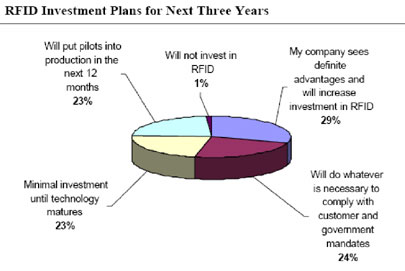Radio frequency identification may have its share of skeptics, but a majority of executives in a range of industries believe in the technology’s potential value, according to a study by consulting and research firm Aberdeen Group, located in Boston.
The firm interviewed senior managers at nearly 250 companies from around the world. Reportedly almost 60 percent of them said RFID has great potential for their companies, while two-thirds indicated the technology would help differentiate their business processes. More specifically, 44 percent said they felt RFID would make their companies more attractive to do business with. However, 52 percent of executives said the technology has yet to deliver real benefits to their company’s internal operations.
|
|
The study breaks down the companies into three categories: market makers (20 percent of total surveyed), willing to invest in the technology and new processes without an immediate promise of ROI; market opportunists (50 percent), which require a clear understanding of ROI; and market laggards (30 percent), indifferent to RFID advances in the near term. The study found that 53 percent of market makers and 31 percent of market opportunists have had RFID pilots in place for more than 12 months. Eventually, all three groups plan to increase spending on RFID hardware and software and services provided by outside companies.
Many of the companies with high hopes for the technology are still struggling to understand the technology and exactly how it will impact their applications and business processes. In fact, more than half of the respondents said RFID’s biggest obstacle today is the inability to get a return on investment. Companies are also waiting for RFID products, particularly middleware, to evolve and improve. Because of that, 48 percent of the executives surveyed replied that their companies are holding RFID projects to pilot phases.
“Everyone thinks RFID is going to be the answer in the future, but no one is quite sure how to extract value from it now,” says John Fontanella, senior VP and research director of Aberdeen’s supply chain consulting practice. “Much more activity has to happen before we hit RFID’s tipping point.”
Companies need to rebuild business processes and practices, or create new ones that can take advantage of the information RFID delivers, Fontanella maintains. For example, using RFID tags on product displays can help consumer goods companies derive more value out of their promotions (see Walgreen to Use Tagged Displays). “If you leave it up to the person stocking the shelves at 2 a.m., at some point these stockers just give up and say they can’t find the promotional displays,” Fontanella explains. “RFID can tell me where a display is, and whether a display has been put on the floor at all.”
In addition, companies need applications and analytical tools that can take advantage of the kinds of information RFID delivers: a product’s state in terms of assembly, and where it is in the process; a product’s condition (such as temperature) and location; and shipping and receipt of goods reconciled with actual orders.
Survey respondents named many of the same obstacles that have been cited since Wal-Mart first told suppliers in 2003 they’d have to begin tagging cases and pallets with RFID by 2005. Namely, they mentioned a lack of compelling value proposition (52 percent), RFID infrastructure costs (36 percent), RFID tag costs (34 percent), a lack of global standards (34 percent) and poor tag read rates (22 percent).
Technical challenges also appear to be on the top of the minds of executives implementing or considering RFID. Most bothersome was the poor performance of RFID tags and readers (41 percent), though immature RFID middleware (39 percent) and a dearth of turnkey RFID systems (37 percent) also headed the list.
Still, Fontanella says new products—coupled with companies turning to active and semi-active tags for those processes affected by UHF passive tags’ physical limitations—will help improve current implementations and create greater ROI. “We’re not going to defy laws of physics, and the reality is, there are some things that [radio signals from] passive UHF tags can’t penetrate,” he says. “We are going to have to figure this out, though. There has been a lot of work on active tags and semi-active tags, and I think people are realizing there are different tags for different applications.”
Fontanella says companies can expect to see new RFID reader-management and network-management and routing tools on the market. RFID reader-management and network-management software helps companies deploy and monitor readers and other RFID products deployed, while routing tools optimize the flow of RFID data throughout the network. In fact, 53 percent said they’ll invest in RFID-specific network-management tools within the next 12 to 24 months, and 44 percent reported their intention to invest in upgraded network-management tools.
Moreover, companies appear to be going beyond the simple slap-and-ship method of affixing RFID tags on the minimum required cases and pallets just to meet mandates from Wal-Mart and other customers. Almost 42 percent of the respondents claimed they are either implementing or investigating RFID’s use for such things as tracking promotions, more accurate sales forecasting by capturing real-time inventory levels and monitoring the entire supply chain from receipt of raw materials to the delivery of finished products to their customers.
All that bodes well for RFID’s future, and it could turn the optimism into reality. Says Fontanella, “There’s risk there, but there’s huge opportunity.”
The Aberdeen Group conducted the survey in concert with Modern Materials Handling magazine and the Web site RFID Update. Executives at 246 companies in the retail, consumer goods, aerospace and defense, pharmaceutical, manufacturing and high-tech industries took part. The surveys were conducted between October and November 2005. Nearly 60 percent of the respondents were from North America; 26 percent of companies reported annual revenues of more than $1 billion, 47 percent said they make from $50 million to $1 billion, and 27 percent claimed less than $50 million.


